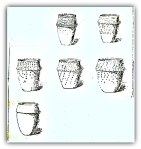OS Grid Reference: Approx. SD 4866 6121. At the northwestern side of Lancaster’s Williamson Park at the place strangely known as Golgotha, in the County of Lancashire, there used to be ‘in olden times’ one or more Bronze Age burial mounds or barrows (tumuli). However, there is nothing to see there today as the barrow(s) were destroyed and the park was, sadly, later built over them in 1881. The barrow(s) were located close to Golgotha Lodge, near the western entrance to the park, which has ‘also’ long since disappeared. The biblical name of Golgotha is usually taken to mean ‘a place of skulls’ or ‘hill of skulls’, which is very apt for a place of death and burial – as we had hearabouts. There also used to be a few drumlins or hummocks (small round-shaped hills) around here which may, or may not, have sometimes been mistaken for burial mounds, although obviously not in the case of this particular (destroyed) barrow, or barrows, located near or in the vicinity of Golgotha Lodge.
The barrow(s) (tumuli) were excavated back in 1865 at which time six or more funery urns were found along with some other, smaller finds (grave goods). Mr. J. Harker (1865, 1872 & 1877) has left us with some good information on the site which was near Golgotha Lodge, Lancaster; the destroyed barrow(s) also sometimes going under the name of ‘Lancaster Moor’. The site had lay close to what is today Wyresdale Road (on a ridge of land ) at the edge of the now Williamson Park; and to the northeast of what were Bowerham Barracks (now St Martin’s College and part of the University of Cumbria). In the vicinity of the barracks there was, apparently, another prehistoric mound or barrow but, once again this suffered destruction, and not much is known about it and its location is now difficult to pin down.
The site entry (No. 6) in the ‘Lancashire Archaeological Bulletin’ (1984) for the parish of Lancaster. Site Name: Lancaster Moor. N.G.R. SD 489 611. Primary Reference: Harker 1865 (=Harker 1877b). Disposition of Finds: Siting “A group of urn was found on Lancaster Moor c.1865. Harker describes the site as being ‘a little to the south of the most elevated part of the people’s recreation group’. This cannot be Highfield Recreation Ground, as the Ordnance Survey record card suggests, since this was not in existence even as late as 1893 (First edition O.S. 25” map). Harker also suggests, in dealing with the Bowerham Barracks find of 1877 (Site 8), that there were only 300 yards between the two discoveries. This suggests the general area of Golgotha Lodge for the 1865 site. He also says ‘At the eastern extremity of the barrows the land inclines steeply towards the Asylum ground’. This must be a down slope, but this and the following sentence are the only places where he uses the word ‘barrows’. The sentence quoted, in conjunction with the siting evidence already quoted, suggests that find covered a considerable area.
Stratigraphy “Eight feet below the then current ground level. The top six feet broken stone recently brought from the quarry. Below this, six inches of ‘dark vegetable soil’. ‘Between this soil and the sandstone rock, ordinary drift deposit and marl’.
Nature of finds “Urns placed ‘in pairs, at intervals of a yard, in a long extended line extending east and west’. (Exactly what does this mean?) Harker describes and illustrates six urns and an accessory vessel. In one of the urns was an unburnt bone from the head of a fish and a tanged bronze spearhead (Not in Davey and Foster 1975). Another contained a bone pin and two perforated cheek pieces of antler. The riveted dagger blade illustrated by Harker (not in Davey and Foster 1975) came from an urn which was not preserved, which was one of a number nearer the Asylum, where, Harker suggested, the ‘free drainage’ resulted in the urns and their contents being ‘so much decayed…as scarcely to be recognisable’. This point about ‘the urns in this part of the barrows’, expressions such as “Some of them….; others….’ and the fact that ‘fragments of several other urns have been brought to me’ show that the total was many more than the six plus an A.V. [accessory vessel] described.
Ritual “It is frequently implied in the report that all pots contained cremated bone. Harker notes an absence of teeth. He describes a cist containing one pot, the remainder of the space with only a flag to cover the mouth. His description of the disposition of Nos. 1 and 2 is hard to follow. They were ‘placed side by side, a thick flag, nearly two feet square between them and another heavy flag resting on the uprights (?) so as to cover the mouth of both vessels’ All pots were apparently upright since the 1872 urn (site 7) was not, and the fact that the 1865 urns were is there mentioned. Illustration from Harker *1977b — Plate A.” [*Should probably read 1877b).
Sources & related websites:-
Edwards, Margaret & Ben, (Editors), Lancashire Archaeological Bulletin, Vol. 10, No. 2/3, May & July 1984.
https://www.lancaster.gov.uk/…/Lancaster%20District%20Housing%20Sites%20-%20I…
http://www.megalithic.co.uk/article.php?sid=6858&m_distance=1.3
http://www.lancaster.gov.uk/sites/williamson-park
http://andrewgough.co.uk/golgotha-england/
https://getoutside.ordnancesurvey.co.uk/local/golgotha-lancaster
© Ray Spencer, The Journal of Antiquities, 2018.


